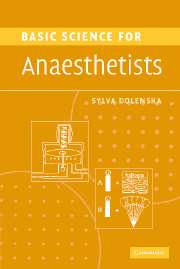Book contents
- Frontmatter
- Contents
- List of abbreviations and symbols
- List of figure captions
- Forewords
- Preface
- Preface to the second edition
- Part 1 Physics, mathematics, statistics, anaesthetic apparatus
- 1 Gas compression, relationship of volume, pressure and temperature
- 2 Real gas compression
- 3 Flow and resistance
- 4 Heat, vaporization and humidification
- 5 Simple mechanics 1: mass, force, pressure
- 6 Simple mechanics 2: work and power
- 7 Mathematical concepts
- 8 Exponentials 1: the curves
- 9 Exponentials 2: properties of exponential decay curve
- 10 Descriptive statistics
- 11 Presentation of data
- 12 Receiver operating characteristic curve
- 13 Gas supply and pressure
- 14 The circle system
- 15 The Mapleson A (Magill) breathing system
- 16 T-pieces
- 17 Lung filling with automatic lung ventilators
- Part 2 Clinical measurement
- Part 3a Physiology: the cardiovascular system
- Part 3b Physiology: the respiratory system
- Part 4 Pharmacology
- Further Reading
- Index
9 - Exponentials 2: properties of exponential decay curve
from Part 1 - Physics, mathematics, statistics, anaesthetic apparatus
Published online by Cambridge University Press: 13 August 2009
- Frontmatter
- Contents
- List of abbreviations and symbols
- List of figure captions
- Forewords
- Preface
- Preface to the second edition
- Part 1 Physics, mathematics, statistics, anaesthetic apparatus
- 1 Gas compression, relationship of volume, pressure and temperature
- 2 Real gas compression
- 3 Flow and resistance
- 4 Heat, vaporization and humidification
- 5 Simple mechanics 1: mass, force, pressure
- 6 Simple mechanics 2: work and power
- 7 Mathematical concepts
- 8 Exponentials 1: the curves
- 9 Exponentials 2: properties of exponential decay curve
- 10 Descriptive statistics
- 11 Presentation of data
- 12 Receiver operating characteristic curve
- 13 Gas supply and pressure
- 14 The circle system
- 15 The Mapleson A (Magill) breathing system
- 16 T-pieces
- 17 Lung filling with automatic lung ventilators
- Part 2 Clinical measurement
- Part 3a Physiology: the cardiovascular system
- Part 3b Physiology: the respiratory system
- Part 4 Pharmacology
- Further Reading
- Index
Summary
Decrease in constant proportion: in practice this means that the rate of decrease depends on the ‘mass’ present. The mass present at any point is graphically represented by the value of the ordinate (y-axis). The rate of decay is not constant, it is the proportion of the mass that is ‘lost’ that is constant: the previously introduced elimination rate constant in fact determines this fixed proportion eliminated per unit of time. For example, when emptying a bath across a fixed resistance (pipe), the flow rate (of emptying) depends directly on the hydrostatic pressure (the level of water) that changes as the bath empties, while the diameter of the pipe determines the proportion of contents that is emptied per unit of time, i.e. the elimination rate constant.
Every section of the curve differs from any other section by scale only: this follows from the first point: because the units of the y-axis are different from those of the x-axis (the time axis), the scale of the y-axis can be arbitrarily chosen. By the same token, any point of an exponential decay curve can be chosen as a ‘starting point’, and the vertical scale can be expanded if values are very small. In practice, this also means that we can project back and forward if we know a part of the curve.
The slope (tangent) at any point is directly proportional to y (the ordinate): this is also another way of saying the first point (the slope of the curve is the rate of decrease).
[…]
- Type
- Chapter
- Information
- Basic Science for Anaesthetists , pp. 36 - 39Publisher: Cambridge University PressPrint publication year: 2006



